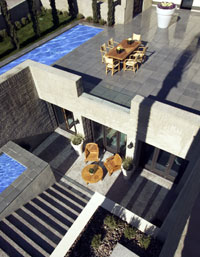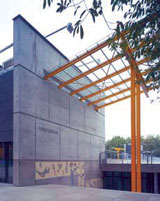Sustainable Design: Foundation for a Sustainable Future
Communities across the United States continue to adopt programs for sustainable development. Durable construction can be an important component of such programs. The durability and fire resistance of non-combustible concrete and masonry construction are qualities that can help communities satisfy their desire to become more sustainable.
How sustainable are structures constructed of materials that will not adequately resist fire spread and may even contribute to a fire? Unlike some other construction alternatives, durable, non-combustible concrete and masonry construction does not fuel a fire.
But beyond the issue of whether or not construction materials will burn is the larger issue of fire containment. Non-combustible concrete and masonry construction can provide fire containment by compartmentalizing multi-family structures so that each living unit is protected from the spread of fire through adjoining walls and floors.
Providing adequate fire containment with minimum two-hour fire-resistant concrete or masonry walls between living units and between living units and public spaces will typically contain fires to the unit of origin. This reduced fire spread not only limits the amount of post-fire repair and reconstruction, but also limits the amount of pollution resulting from burning contents within the building.
Following disasters, fires may burn out of control due to reduced resources or access and/or loss of water supply. Concrete and masonry construction can limit the size and spread and of such fires.
Following the devastation from wind and water and related environmental impacts of Hurricane Katrina, uncontrolled fires destroyed remaining structures adding to the pollution problems.
Such uncontrollable fires can lead to fire storms spreading to multiple buildings and even blocks of buildings. Water supply, available resources and access may be limited due to wildland fires; hurricanes, tornadoes or other high wind events; ice or snow storms; and earthquakes. See more on Resilience.
Non-combustible concrete and masonry construction provides many other benefits to communities seeking to promote sustainable development, such as:
- thermal mass benefits for reduced heating and cooling needs
- durability for reduced building replacement and increased building reuse
- low maintenance and reduced need for routine painting or frequent cleaning in order to retain a desirable appearance
- sound transmission resistance, creating more comfortable living and more productive work environments
When it comes to building construction for sustainable development, there is no comparison to non-combustible concrete and masonry construction. For more information about combining smoke detectors, fire sprinklers, and passive fire protection visit the Pennsylvania Fire Safety Construction Advisory Council.
Developments in Material and Techniques Keep Concrete a Leader in Green Building Movement
The design world today is faced with myriad choices when it comes to sustainable design and construction. “Green” materials and techniques are no longer a novelty—they are practically ubiquitous, present in every stage of design, construction, operation and maintenance. Big business is embracing green building, governmental bodies are rewarding sustainable efforts, and individuals across the globe are making everyday decisions about materials and methods that will impact generations to come.

It makes sense, then, that forward thinkers in design and construction are re-connecting with concrete. The most widely used construction material on earth, concrete has the longest lifespan of any traditional building material, used to create structures that still stand after more than 2,000 years.
Buildings and homes constructed with high-performance concrete wall systems offer excellent energy efficiency, guarding against daily temperature fluctuations and providing occupants with greater comfort and lower heating and cooling bills. The reflectivity of light-colored concrete in paving and sidewalks helps reduce the urban heat island effect, reducing the potential for smog and cutting costs for air conditioning.
Because concrete is designed for each specific project, there is very little waste, and the material enjoys unlimited flexibility in applications ranging from high-rises to parking lots, bridges to stadiums. And when a concrete structure has served its purpose, the material can be crushed and recycled for other functions.
Concrete may be our oldest building material, but modern innovations in technology and technique keep it at the forefront of sustainable design and construction. Today, the cement industry is taking great steps to improve the efficiency of its manufacturing process, bringing sustainability to the source of concrete materials. The environmental future of concrete is solid.
HPBRS and Green Building Codes
 To help local governments and Federal agencies develop and implement green building codes, PCA has developed High Performance Building Requirements for Sustainability, a sample ordinance written in mandatory language that amends and appends the International Code Council International Building Code (IBC) to address high performance and sustainable buildings.
To help local governments and Federal agencies develop and implement green building codes, PCA has developed High Performance Building Requirements for Sustainability, a sample ordinance written in mandatory language that amends and appends the International Code Council International Building Code (IBC) to address high performance and sustainable buildings.
The requirements include the concepts in most other sustainability or green standards that are within the purview of the building code department while enhancing disaster resistance and setting more stringent durability requirements.
PCA has aligned the provisions with the concepts of both the Whole Building Design Guide (wbdg.org) and High Performance Building Council. Enacting and enforcing these provisions provides the basis for designers and owners to obtain certification as a US Green Building Council (USGBC) Leadership in Energy and Environmental Design for New Construction (LEED-NC).
The ordinance is organized by chapter and section consistent with the IBC format and is intentionally limited to issues typically within the purview of the building code and zoning and land use officials. There are no requirements for sole source certification or fees that increase the initial project design cost.
Major features of the provisions are:
- Requires a design service life plan.
- Mandatory to use the ICC International Wildland-Urban Interface Code.
- High performance fire safety provisions include mandatory sprinkler requirements, structural fire resistance required for all buildings, and incorporates redundant fire safety requirements (notable changes apply to residential and assisted living facilities due to the aging population)
- Scoping provisions for storm shelters are provided for ICC/NSSA - 500 Standard for the Design and Construction of Storm Shelters.
- Limitations on indoor materials for volatile organic compounds (VOCs).
- Enhanced indoor air quality with provisions for air filtering systems, carbon dioxide detection, and recreational smoking.
- Improved occupant productivity and comfort with noise control provisions.
- Improved energy performance by exceeding the International Energy Conservation Code by 20 percent and additional requirements for daylighting, fenestration, and air barriers.
- Solar reflectance indices for opaque walls and roofs to minimize internal heat gain and heat island effects.
- Increased design wind pressure and design force by 20 percent for most buildings (there is only a 5 percent increase for critical infrastructure buildings that already have more stringent requirements)
- Flood resistance is increased to be at least three feet above base flood elevation or five hundred year flood elevation if known and does not permit consideration of flood protective works such as dams, levees, flood waters, etc.
- Building water use reduction requirements.
- Material resource requirements recycling, construction waste, material transportation, and pollution prevention.
- Requirements for site development and site improvements.